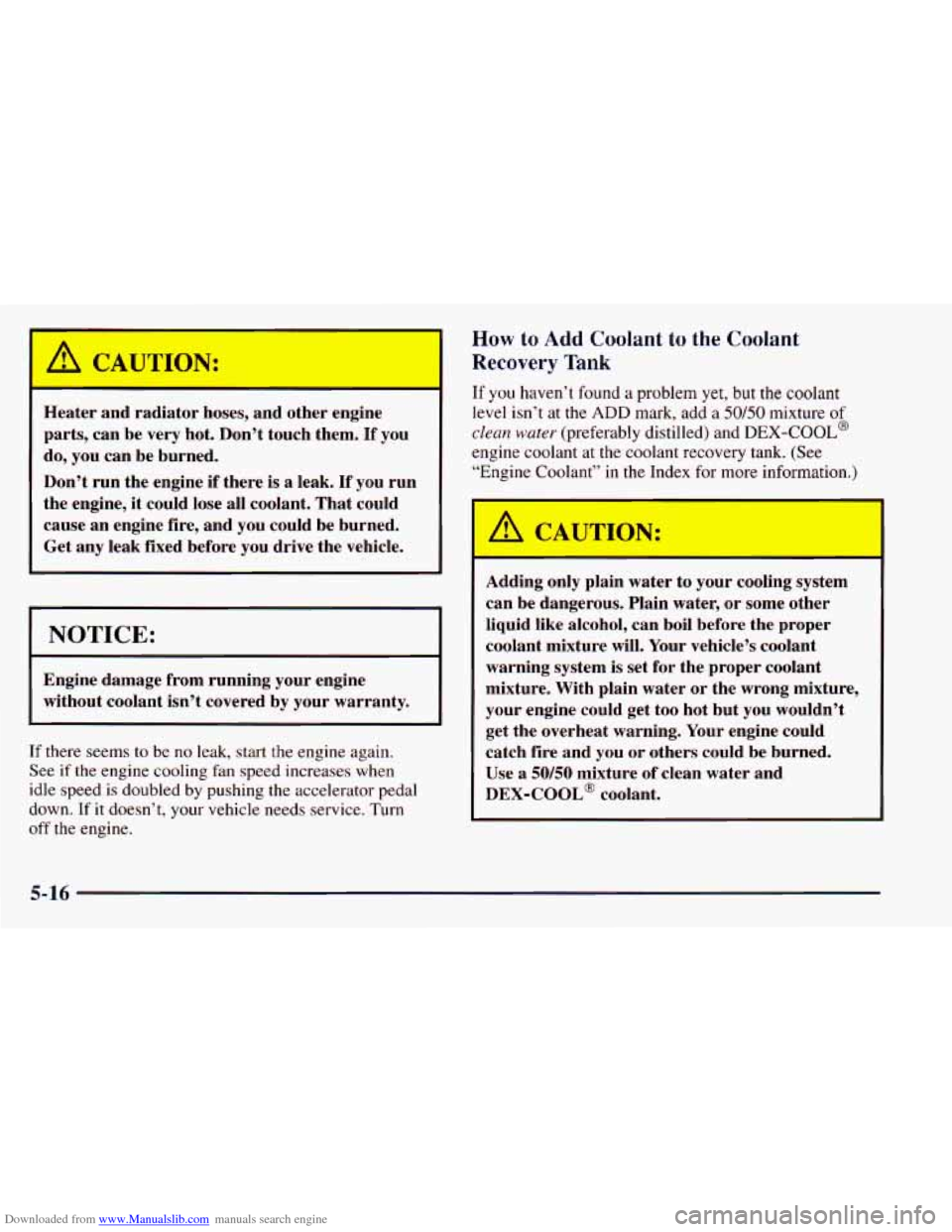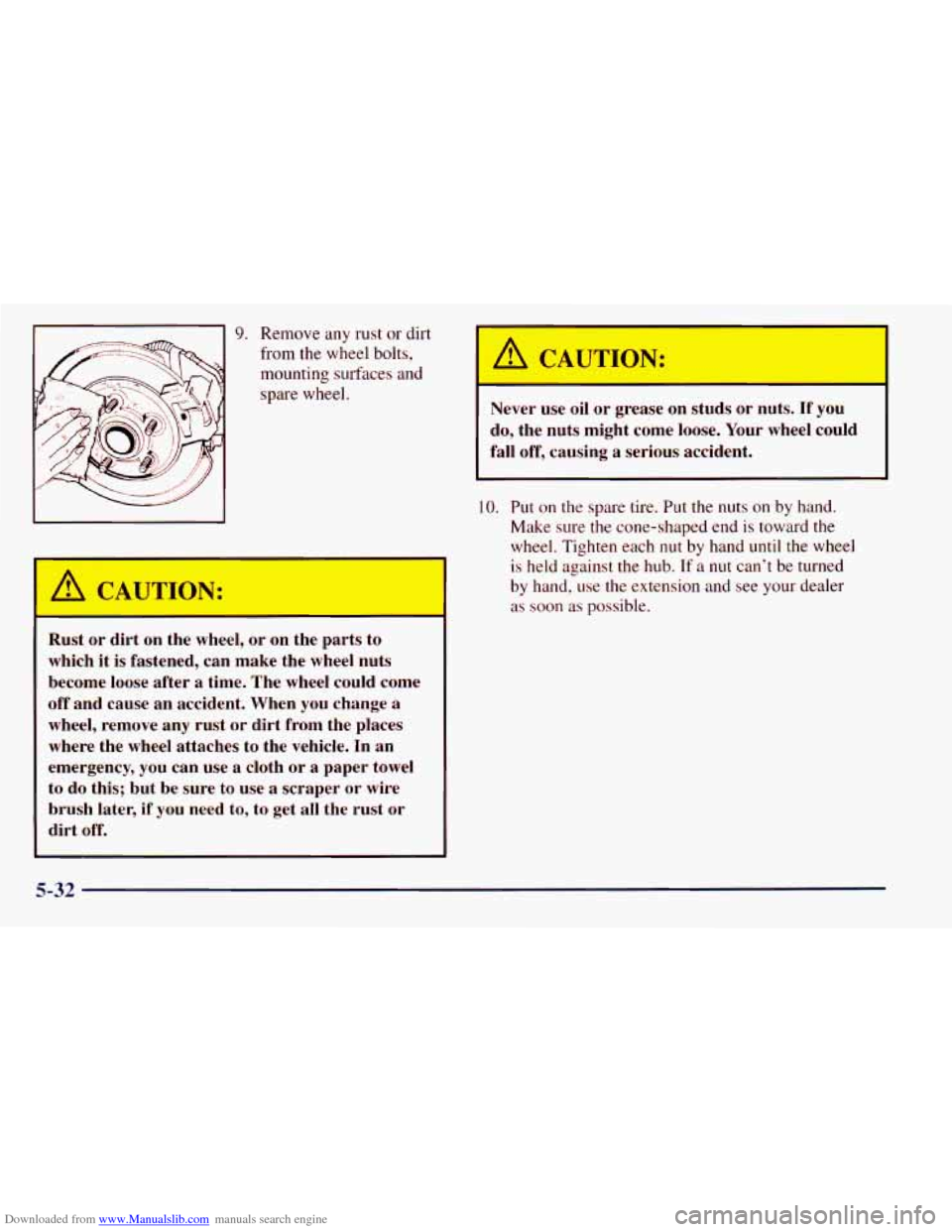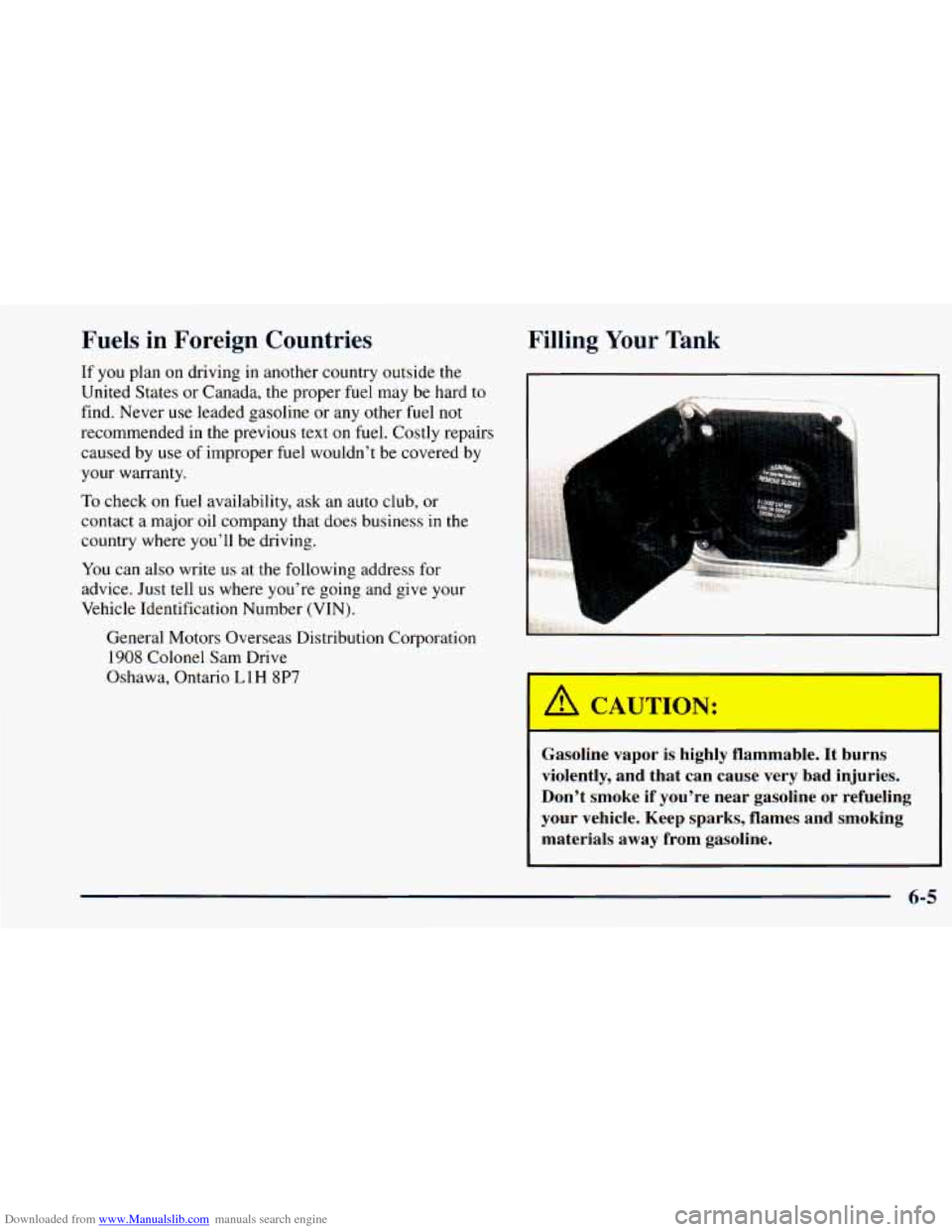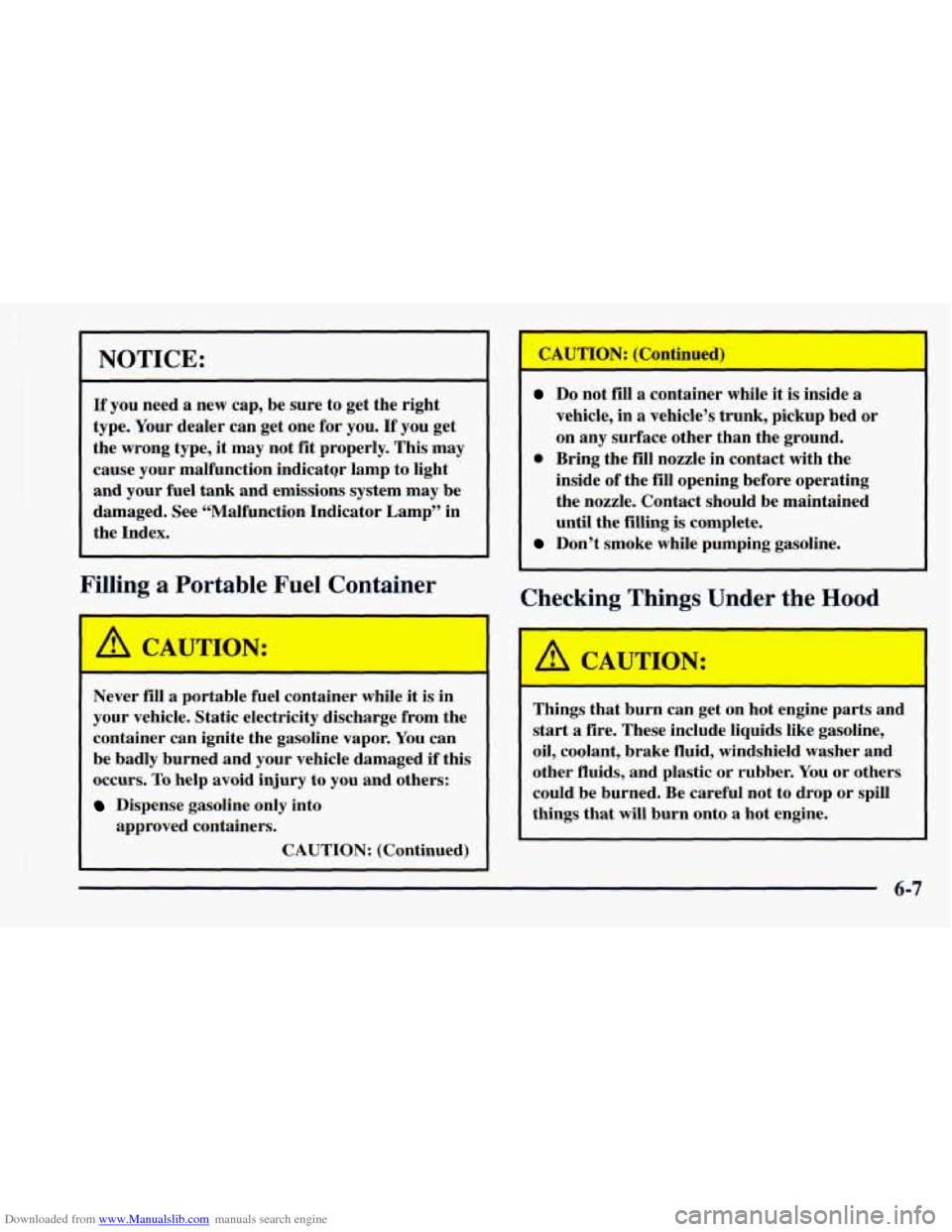Page 237 of 414
Downloaded from www.Manualslib.com manuals search engine Cooling System
When you decide it’s safe to lift the hood, here’s what
you’ll see:
A. Coolant Recovery Tank
B. Radiator Pressure Cap
C. Engine Fan
If the coolant inside the coolant recovery tank is boiling,
don’t do anything else until
it cools down. The
coolant level should be at the
ADD mark.
If it isn’t, you may have
a leak in the radiator hoses,
heater hoses, radiator, water
pump or somewhere else in
the cooling system.
5-15
Page 238 of 414

Downloaded from www.Manualslib.com manuals search engine [6h, CAUTION:
Heater and radiator hoses, and other engine
parts, can be very hot. Don’t touch them.
If you
do, you can be burned.
Don’t run the engine if there is
a leak. If you run
the engine, it could lose all coolant. That could
cause an engine fire, and you could be burned.
Get any leak fixed before you drive the vehicle.
I NOTICE: I
Engine damage from running your engine
without coolant isn’t covered by your warranty.
If there seems to be no leak, start the engine again.
See if
the engine cooling fan speed increases when
idle speed is doubled
by pushing the accelerator pedal
down. If it doesn’t,
your vehicle needs service. Turn
off the engine.
How to Add Coolant to the Coolant
Recovery Tank
If you haven’t found a problem yet, but the coolant
level isn’t at the
ADD mark, add a 50/50 mixture of
clean water (preferably distilled) and DEX-COOL@
engine coolant at the coolant recovery tank. (See
“Engine Coolant” in the Index for more information.)
A CAUTION:
Adding only plain water to your cooling system
can be dangerous. Plain water, or some other
liquid like alcohol, can boil before the proper
coolant mixture will. Your vehicle’s coolant
warning system is set for the proper coolant
mixture. With plain water or the wrong mixture,
your engine could get too hot but you wouldn’t
get the overheat warning. Your engine could
catch fire and you
or others could be burned.
Use a
50/50 mixture of clean water and
DEX-COOL@ coolant.
5-16
Page 254 of 414

Downloaded from www.Manualslib.com manuals search engine 9. Remove any rust or dirt
from the wheel bolts,
mounting surfaces and
spare wheel. I A CAUTION:
L
Rust or dirt on the wheel, or on the parts to
which it is fastened, can make the wheel nuts
become loose after
a time. The wheel could come
off and cause
an accident. When you change a
wheel, remove any rust or dirt from the places
where the wheel attaches to the vehicle. In an
emergency, you can use a cloth or
a paper towel
to
do this; but be sure to use a scraper or wire
brush later,
if you need to, to get all the rust or
dirt off.
I1
Never use oil or grease on studs or nuts. If you
do, the nuts might come loose. Your wheel could
fall off, causing
a serious accident.
10. Put on the spare tire. Put the nuts on by hand.
Make sure the cone-shaped end is toward
the
wheel. Tighten each nut by hand until the wheel
is held against the hub. If a nut can’t be turned
by hand, use the extension and see your dealer
as
soon as possible.
5-32
Page 263 of 414

Downloaded from www.Manualslib.com manuals search engine Section 6 Service and Appearance Care
Here you will find information about the care of your vehicle. This section begins with service and fuel information,
and then it shows how to check important fluid and lubricant levels. There is also technical infc lation about your
6-2
6- 3
6-
5
6-7
6-7
6- 10
6- 15
6- 19
6-20
6-23
6-25
6-25
6-28
6-29 6-29
6-30
6-3
1
6-35 vehicle,
and a part devoted to its appearance care.
Service
Fuel
Filling Your Tank
Filling a Portable Fuel Container
Checking Things Under the Hood
Engine Oil Engine Cover
Air Cleaner
Automatic Transmission Fluid
All-Wheel Drive
Rear Axle
Engine Coolant
Radiator Pressure Cap
Thermostat
Power Steering Fluid
Windshield Washer Fluid
Brakes
Battery 6-36
6-36
6-42
6-42
6-5 1
6-5
1
6-53
6-55
6-56
6-57
6-57
6-58
6-59
6-59 6-60
6-67
6-68
6-69 Bulb
Replacement
Halogen Bulbs
Windshield Wiper Blade Replacement
Tires
Appearance Care
Cleaning the Inside of Your Vehicle
Cleaning the Built-in Child Restraint
Cleaning the Outside
of Your Vehicle
Cleaning Tires
Finish Damage
Underbody Maintenance
Appearance Care Materials Chart
Vehicle Identification Number (VIN)
Service Parts Identification Label
Electrical System
Capacities and Specifications
Air Conditioning Refrigerants
Normal Maintenance Replacement Parts
6-1
Page 267 of 414

Downloaded from www.Manualslib.com manuals search engine Fuels in Foreign Countries
If you plan on driving in another country outside the
United States or Canada, the proper fuel may be hard to
find. Never use leaded gasoline or any other fuel not
recommended in the previous text on fuel. Costly repairs
caused by
use of improper fuel wouldn’t be covered by
your warranty.
To check on fuel availability, ask an auto club, or
contact
a major oil company that does business in the
country where you’ll be driving.
You can also write
us at the following address for
advice. Just tell us where you’re going and give your
Vehicle Identification Number (VIN).
General Motors Overseas Distribution Corporation
1908 Colonel Sam Drive
Oshawa, Ontario
L1H 8P7
Filling Your Tank
A CAUTION:
--
Gasoline vapor is highly flaml,,~ble. It burns
violently, and that can cause very bad injuries.
Don’t smoke if you’re near gasoline or refueling
your vehicle. Keep sparks, flames and smoking
materials away from gasoline.
6-5
Page 269 of 414

Downloaded from www.Manualslib.com manuals search engine I
NOTICE:
If you need a new cap, be sure to get the right
type. Your dealer can get one for you.
If you get
the wrong type, it may not fit properly. This may cause your malfunction indicator lamp to light and your fuel tank and emissions system may be
damaged. See “Malfunction Indicator Lamp” in
the Index.
Filling a Portable Fuel Container
A CAUTION:
Never fill a portable fuel container while it is in
your vehicle. Static electricity discharge from the
container can ignite the gasoline vapor.
You can
be badly burned and your vehicle damaged if this
occurs.
To help avoid injury to you and others:
Dispense gasoline only into
approved containers.
CAUTION: (Continued)
I
Do not fill a container whilc : is inside a
vehicle, in a vehicle’s trunk, pickup bed or
on any surface other than the ground.
inside of the fill opening before operating
the nozzle. Contact should be maintained
until the filling
is complete.
0 Bring the fill nozzle in contact with the
Don’t smoke while pumping gasoline.
Checking Things Under the Hood
A CAUTION: I
Things that burn can get on hot engine parts and
start a fire. These include liquids like gasoline,
oil, coolant, brake fluid, windshield washer and
other fluids, and plastic
or rubber. You or others
could be burned. Be careful not to drop or spill
things that will burn onto a hot engine.
6-7
Page 271 of 414
Downloaded from www.Manualslib.com manuals search engine When you open the hood, this is what you will see:
A. Windshield Washer Fluid Fill Location
B. Coolant Fill Location
C. Oil Dipstick Location
D. Transmission DipsticWill Location
E. Air Cleaner
F. hngine Oil b111 Location
G. Brake Master Cylinder Reservoir
H. Power Steering Fluid Reservoir
I. Battery
6-9
Page 272 of 414
Downloaded from www.Manualslib.com manuals search engine I
I
Lift the hood, release the hood prop from its retainer and
put the hood prop into the slot in the hood.
Before closing the hood, be sure all the filler caps
are on
properly. Then lift the hood to relieve pressure on the
hood prop. Remove the
hood prop from
the slot in the hood and
I return the
Drop to its retainer. 1.L
Then just pull the hood
down and close it firmly.
Engine Oil
It's a good idea to check your engine oil every time you
get fuel.
In order to get an accurate reading, the oil must
be warm and the vehicle must be on level ground.
6-10